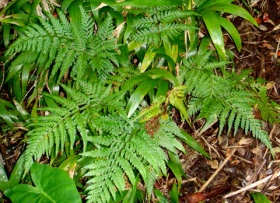A New Fern, Lastreopsis Kermadecensis

Te Papa Research Fellow Patrick Brownsey and I (Leon Perrie) have just described a new species of fern, Lastreopsis kermadecensis. It only occurs on Raoul Island, which is the largest island in the Kermadec Islands group. Hence, the second part of the new species name!
The Kermadec Islands are the most northern part of the New Zealand Botanical Region. Raoul Island is about 980 km north-east of the North Island. Much of the indigenous flora is similar to mainland New Zealand. But there are a number of plants that occur on the Kermadec Islands and elsewhere in the tropical south Pacific but not in mainland New Zealand. There are also about 25 vascular plant species that are only found on the Kermadec Islands, like this new fern.
Wikipedia’s entry on the Kermadec Islands.
Some of the specimens from the Kermadec Islands amongst Te Papa’s collections.
While the official description of Lastreopsis kermadecensis is only recent, it has actually been suspected for nearly 50 years that the Lastreopsis on Raoul Island was a distinct species. But it wasn’t until now that someone (us) did the work to test whether this was indeed the case. This involved comparing specimens from Raoul Island, New Zealand, Australia, and elsewhere in the Pacific. The work was completely collections-based; neither Pat nor I have been to the Kermadec Islands! Instead, we used specimens from the collections of Te Papa, Auckland Museum, Landcare Research, the Royal Botanic Gardens Sydney, the Queensland Herbarium, and Hawaii’s Bishop Museum.
Abstract of the paper describing Lastreopsis kermadecensis.
Lastreopsis kermadecensis looks similar to New Zealand’s smooth shield fern, Lastreopsis glabella. Lastreopsis glabella is a common forest fern. You will have undoubtedly seen it if you’ve spent any time in New Zealand’s forests, even if you didn’t recognise it. One of the differences between Lastreopsis kermadecensis and Lastreopsis glabella is that the latter has an abundance of small, orange glands on the undersides of its fronds. Lastreopsis kermadecensis is actually most similar to Lastreopsis smithianafrom eastern Australia, but there are several differences which we felt were sufficient to treat them as distinct species.
Pictures of New Zealand Lastreopsis from Te Papa’s Collections Online.
The formal description of Lastreopsis kermadecensis means we now recognise 196 ferns and lycophytes indigenous to New Zealand. We are aware of several additional undescribed or unrecognised species, so a few more years of work will see the list top 200.
Te Papa’s list of New Zealand ferns and lycophytes.
Incidentally, Lastreopsis kermadecensis is one of the first New Zealand plants to be described under the changed rules that allow electronic publication of new scientific names.
Article from Te Papa's blog.












